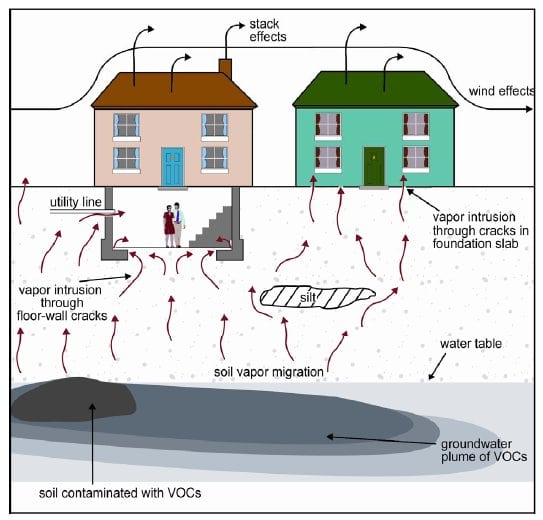Vapor Intrusion: The Latest Environmental Issue
Friday, October 4th, 2013
By: Steve Goldman, CCIM

Typical migration pathways of volatile chemicals from contaminated soil and groundwater into buildings | Image courtesy of epa.gov
Published by EPA.GOV
Vapor intrusion generally occurs when there is a migration of volatile chemicals from contaminated groundwater or soil into an overlying building. Volatile chemicals can emit vapors that may migrate through subsurface soils and into indoor air spaces of overlying buildings in ways similar to that of radon gas seeping into homes. Volatile chemicals may include volatile organic compounds, select semivolatile organic compounds, and some inorganic analytes, such as elemental mercury, radon, and hydrogen sulfide.
In extreme cases, the vapors may accumulate in dwellings or occupied buildings to levels that may pose near-term safety hazards (e.g., explosion), acute health effects, or aesthetic problems (e.g., odors). Typically, however, the chemical concentration levels are low or, depending on site-specific conditions, vapors may not be present at detectable concentrations. In buildings with low concentrations of volatile chemicals, the main concern is whether the chemicals may pose an unacceptable risk of chronic health effects due to long-term exposure to these low levels. A complicating factor in evaluating the potential chronic risk from vapor intrusion is the potential presence of some of the same chemicals from emission sources in the building (e.g., household solvents, gasoline, cleaners) that may pose, separately or in combination with vapor intrusion, a significant human health risk.
The simple conceptual model of the vapor intrusion pathway that is presented in Figure 1 illustrates a source of contamination in soil and groundwater and the upward movement of VOCs from this source toward and into buildings. (Source: The 2008 Brownfields Technology Primer: Vapor Intrusion Considerations for Redevelopment, EPA 542-R-08-001.)
If you have concerns about vapor intrusion where you live or work, please contact your state health department.
Back to Blog
